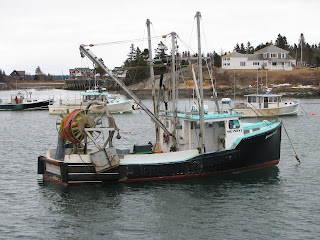
The Maine Fishermen's Forum is coming up at the Samoset Resort in Rockport next weekend. I'm planning to go, because it is the event in Maine to go to if you want to find out what is happening with commercial fisheries in the state. There's been plenty of changes (some might say 'upheaval') in Maine's fisheries this past year - lobster, herring and scallops are just a few examples (see earlier posts) - and all will be discussed at the forum. There also will be seminars on ocean energy, aquaculture, groundfish, shrimp, and many things lobster. Maine Lobstermen's Association has flown in a group of lobstermen from around the world to talk to Maine fishermen about what they do back home and to compare notes. You can check out the forum Web site if you want to see what's on the schedule.
Here's a press release from forum organizers, for those of you that are interested:
"The Maine Fishermen’s Forum, which takes place at the Samoset Resort in Rockport on March 4, 5 and 6 this year will have a vastly mixed offering in both seminar subjects and trade show exhibitors this year. From the introduction of Eric Schwaab, the newly appointed Assistant Administrator of NOAA Fisheries to a well rounded Gubernatorial Candidate Forum featuring a number of the political contenders, the Forum has multiple options. Seminar offerings will include a discussion of an Experimental Summer Shrimp Fishery, Atlantic Herring and River Herring seminars, Permit Buyout information, and Sectors and the Common Pool, among others.
On Thursday, March 4th, there is a comprehensive Clam Day seminar addressing issues from Red Tide, Pollution Abatement, Conditional Classifications of Shellfish and Shellfish Management. Also, there is a rare opportunity for Maine fishermen to meet lobstermen from around the world including New Zealand, Australia, Ireland and Puerto Rico.
The annual Scholarship Benefit Auction will take place on Friday, March 5; all proceeds will go to students from Maine families involved in the seafood industry. A huge assortment of items are to be auctioned from lobster traps, transducers, and paintings to Samoset gift certificates and DeLorme Gazetteers! Participation is free and highly encouraged!
The Maine Fishermen’s Forum is free to attend, as is the Trade Show and the Auction. For more information, please check the website at www.mainefishermensforum.org or contact Forum Coordinator Chilloa Young at (207) 442-7700."
If you can't make it, keep an eye on Downeast Denizen to get a glimpse of some of the forum's happenings. As always, it should be interesting.











